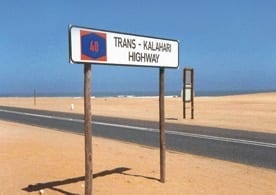Stakeholders from Namibia, Botswana and South Africa recently conducted a road safety assessment on the Trans Kalahari Corridor (TKC).
The aim of the road assessment was to provide an overview of the road infrastructure, map border processes and procedures and give stakeholders a chance to observe the movement of cargo and identify bottlenecks. Stakeholders were said to be impressed by the current road conditions between Walvis Bay and the Trans Kalahari border post. The Namibia Roads Authority is tasked with continuously maintaining and upgrading the roads on the Namibian side of the corridor. Botswana’s efficient border processes received praise from the stakeholders as well. A state of the art weighbridge, able to weigh an entire truck and trailer, is being installed at the Pioneers Gate on the South African side of the corridor in an effort to increase further efficiencies. Stakeholders are expected to formulate a report underpinning their findings and proposing actions to improve impediments identified along the corridor, in order to ensure the smooth and efficient transportation of cargo along the TKC. The last road assessment done on the TKC took place in April 2010.The TKC is a road network spanning approximately 1900km across the territories of Botswana, Namibia and South Africa. It starts in the Gauteng Province in South Africa and continues through Rustenburg and Zeerust in the North-West Province, through Lobatse and Kanye in Botswana, the Mamuno and Trans-Kalahari Border Posts, through Gobabis, Windhoek and Okahandja in Namibia and right through to the Port of Walvis Bay.
The TKC was established with a political and economic vision to pursue or contribute towards deeper regional integration programs of SADC, SACU and NEPAD. This corridor is known for providing a short transport link across the entire breadth of the South African Sub-continent. Compared to the traditional routes via southern Namibia to South Africa’s Gauteng, the TKC cuts the distance by 400km, making it a more preferred route and providing cost effective logistical advantages to users. The port of Walvis Bay on the west coast of Namibia strategically links to other corridors in the sub-region, namely: Trans Kunene Corridor, Walvis Bay-Ndola-Lubumbashi Corridor, Windhoek-Luanda Corridor and Trans Oranje Corridor. Road network linkages cut across these Corridors creating a strategic network. The TKC also connects the ports of Walvis Bay with the Maputo Corridor, resulting in the Coast-to-Coast Corridor and is a strategic route-of-choice that provides linkages between the Americas and East European markets and the Southern African hinterland.







